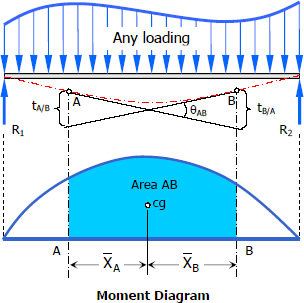Area-Moment Method | Beam Deflections
Another method of determining the slopes and deflections in beams is the area-moment method, which involves the area of the moment diagram.

Theorems of Area-Moment Method
Theorem I
The change in slope between the tangents drawn to the elastic curve at any two points A and B is equal to the product of 1/EI multiplied by the area of the moment diagram between these two points.
$\theta_{AB} = \dfrac{1}{EI}(Area_{AB})$
Theorem II
The deviation of any point B relative to the tangent drawn to the elastic curve at any other point A, in a direction perpendicular to the original position of the beam, is equal to the product of 1/EI multiplied by the moment of an area about B of that part of the moment diagram between points A and B.
$t_{B/A} = \dfrac{1}{EI}(Area_{AB}) \cdot \bar X_B$
and
$t_{A/B} = \dfrac{1}{EI}(Area_{AB}) \cdot \bar X_A$

- The deviation at any point is positive if the point lies above the tangent, negative if the point is below the tangent.
- Measured from left tangent, if θ is counterclockwise, the change of slope is positive, negative if θ is clockwise.
- Log in to post comments
